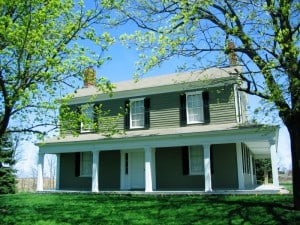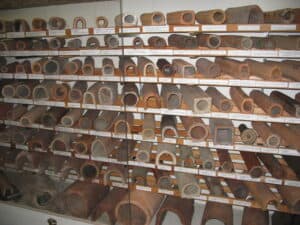From Home to Museum: A Brief History of Johnston House
By Kerry Lippincott, Executive Director

Johnston House
Whether it’s a hazard of the profession or just curiosity, I’ve developed an interest in how private homes evolve into historic house museums. Built around 1821, the Johnston House was a family home until 1990. During the Johnston’s tenure (1821-1877) John and Margaret Johnston raised six daughters and two granddaughters and hosted various farm workers. Even before he retired and moved to 533 South Main Street in Geneva with three of his daughters, Johnston began renting out parts of his 306-acre farm. Between 1868 and 1877 forty acres was rented to Maxwell Nurseries. Once the family moved into Geneva the entire farm was rented until 1889.

Image of the site during the Mellen Tenure (1889-1934).
In 1889 Charles S. Mellen (1858-1925) purchased the farm from Johnston’s daughters. Mellen turned the property into stock farm with horses, sheep, swine, and cattle. He lived in the former Johnston home until 1908 when he and his family moved across the road to Broad Meadows farm. The Mellen family gave the land which the former Johnston House sits on to Hobart College in 1934. It was Hobart who gave permission for the memorial boulder for Johnston to be installed on the property.
Cornelius Dwyer (owner of Belhurst Castle) purchased the property from Hobart in 1943. We do not know his plans for the site because Dwyer only owned it for about a year before he sold it to Bert Welch (1882-1965). Welch ran the property as a dairy farm with wheat raised as a cash crop. The property and Rose Hill Mansion were part of over 800 acres Welch owned in Seneca County. Welch lived in the former Johnston House with his wife Louise until his death in 1965. Louise continued to live in the house until her death thirty-five years later.
Historic Geneva purchased the house along with 1.4 acres of land in 1991 and it became part of the Rose Hill Mansion Complex. Like he did with Rose Hill Mansion, Merrill Roenke supervised the restoration of the Johnston House. The decision was made to restore the house (inside and out) as near as possible to its original 1821 appearance. The house was restored between 1991 and 1993. Among the things done to the house were all the modern bathrooms and kitchen fixtures removed; the wall paper was stripped from the walls; layers of overlay floors were removed to expose the original floor; the main chimneys were rebuilt; and a new roof and porches were installed.

In 1994 Mike Weaver’s drain tile collection was displayed in the north parlor.
When finished the Johnston House was to serve as a drain tile museum. In 1992 Historic Geneva received 350 drain tiles from Mike Weaver (a former civil engineer and author of History of Tile Drainage in American Prior to 1900 ) along with his tiling tools and research materials. The Mike Weave Drain Tile Museum at Johnston House opened in May 1994. Inside the house there was space devoted to an exhibit about the history of agriculture and tile drainage, a research room with Weaver’s materials, a display room for drain tiles, and the Johnston Room with many original furnishings from the family. The drain tile collection was moved to another building in 2008 and the house was reinterpreted to reflect life on a mid-nineteenth century farm. Currently, the Johnston House features furnished period rooms, and exhibits on technology, agriculture and immigration.
2021 marks the 200th anniversary of Johnston settling in the area. Historic Geneva is commemorating the anniversary with an exhibit on Geneva innovators, blog articles, and social media posts.
Historic Geneva tells the stories of Geneva, New York. Discover these stories online and in person through the Geneva History Museum, Rose Hill Mansion, and Johnston House.

Kerry,
Enjoyed reading about the Johnston House. Learned a great deal that I did not know.
I knew Bert Welch in the 50s when I worked in a local grocery store. He was an interesting fellow. Didn’t spend much money on himself or his property but he had plenty. One of Louise’s daughters baby-sat for me in the 1940s
I was director during the restoration of the Johnston House and Steve O’Malley designed and built the display of Mike Weaver’s drain tile. It is quite a collection.
Hi Kerry:
I enjoyed reading your short history of Johnston House. Just a few comments. The
Charles S. Mellen you refer to is really Charles Rose Mellen (1858-1925). He was Grand-
father of my Wife, Susan (Virginia) Mellen Sabin. He also is of the Rose Family that
migrated to Geneva in early 1800’s. I direct your attetion to Verne Marshall’s book
“The Roses of Geneva 1993” Page 54. I am puzzled by your mention that ownership passed
to Hobart College in 1934 when owner Charles Roe Mellen died in 1925!?
Howard,
Glad you enjoyed the article. My curiosity about the owners of Johnston House was peaked by an 1935 newspaper article about the Johnston Memorial boulder. In the article it stated that Hobart gave permission for the boulder to be installed and agreed to care for it. Why would Hobart do this? The deed abstract lists all the property transfer. According to that, on June 8, 1934 the Mellen family gave the property which the Johnston House stands on to Hobart College. In August 1943 Hobart sold it to Dwyer.
In th neighborhood of 1960 Bert Welch owned 800 acres in seneca county and built a state of the art dairy barn. Bert did not beive in bank. He pd 100k in cash. He had an trust issue with his stepsons,the Kirby boys, so it’s said he buried his fortune somewhere within his 800 acres. Living in the next house up Rose Hill ,we would always see people with shovels digging across the street.
When he passed(I believe in mid 60s) he had no will and no money.